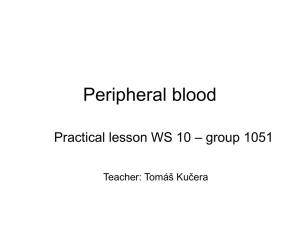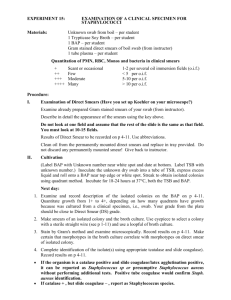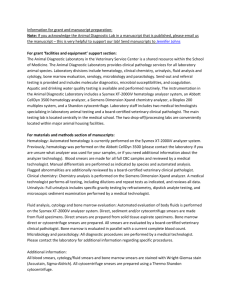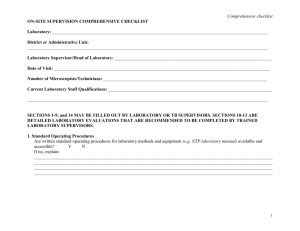- Worldwide Antimalarial Resistance Network
advertisement
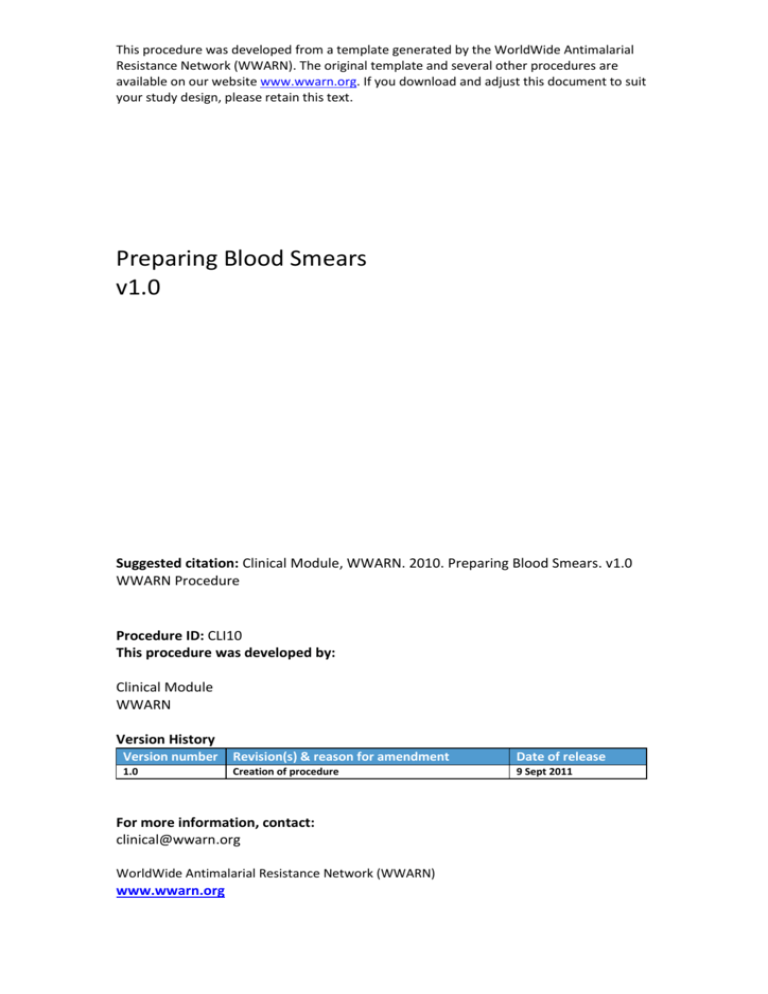
This procedure was developed from a template generated by the WorldWide Antimalarial Resistance Network (WWARN). The original template and several other procedures are available on our website www.wwarn.org. If you download and adjust this document to suit your study design, please retain this text. Preparing Blood Smears v1.0 Suggested citation: Clinical Module, WWARN. 2010. Preparing Blood Smears. v1.0 WWARN Procedure Procedure ID: CLI10 This procedure was developed by: Clinical Module WWARN Version History Version number Revision(s) & reason for amendment Date of release 1.0 Creation of procedure 9 Sept 2011 For more information, contact: clinical@wwarn.org WorldWide Antimalarial Resistance Network (WWARN) www.wwarn.org This procedure was developed from a template generated by the WorldWide Antimalarial Resistance Network (WWARN). The original template and several other procedures are available on our website www.wwarn.org. If you download and adjust this document to suit your study design, please retain this text. Contents 1. Purpose ......................................................................................................................3 2. Scope ..........................................................................................................................3 3. Abbreviations .............................................................................................................3 4. Duties and Responsibilities ........................................................................................3 4.1 General information ............................................................................................3 4.2 Tasks .....................................................................................................................3 5. Materials and Equipment ..........................................................................................4 6. Procedure ...................................................................................................................4 6.1 Labeling Slides ......................................................................................................4 6.2 Making Smears .....................................................................................................5 6.3 Preparation of Alkaline and Acid buffers .............................................................5 6.4 Preparation of Giemsa Staining Buffer ................................................................ 5 6.5 Staining Thick Smears ..........................................................................................6 6.6 Staining Thin Smears ............................................................................................6 6.7 Mounting slides....................................................................................................6 6.8 Quality Control .....................................................................................................6 7. References .................................................................................................................7 WWARN Procedure: Preparing Blood Smears v1.0 Page 2/7 This procedure was developed from a template generated by the WorldWide Antimalarial Resistance Network (WWARN). The original template and several other procedures are available on our website www.wwarn.org. If you download and adjust this document to suit your study design, please retain this text. 1. Purpose The purpose of this document is to describe the procedure for preparing thick and thin blood smears, staining with Giemsa, and mounting slides for the purpose of diagnosing asymptomatic parasitemia, clinical malaria, and monitoring response to antimalarial therapy. Thick smears are generally used to make the diagnosis of malaria, calculate parasite density and look for the presence of gametocytes. Thin smears are generally used to determine the species of malaria parasites. 2. Scope This procedure is intended for use in clinical trials where patients are attending a clinic for antimalarial treatment. Training of staff is required in order to successfully use the protocol. 3. Abbreviations mL g µL millilitres grams microlitres 4. Duties and Responsibilities 4.1 General information This section outlines the list of tasks required to complete this procedure. These tasks should be assigned to individual(s) capable of their execution and their name entered beside the task listed in the table below. 4.2 Tasks Study personnel Label slides Prepare buffer solutions Take blood and make a blood smear Stain smear Mount slides WWARN Procedure: Preparing Blood Smears v1.0 Page 3/7 This procedure was developed from a template generated by the WorldWide Antimalarial Resistance Network (WWARN). The original template and several other procedures are available on our website www.wwarn.org. If you download and adjust this document to suit your study design, please retain this text. 5. Materials and Equipment One or two glass slides (thick smear, +/- thin smear) Pencil One cover slip Wooden applicator stick Methanol DPX (a mixture of distyrene (a polystyrene), a plasticizer (tricresyl phosphate), and xylene,) mounting solution Giemsa stain Giemsa buffer [Na2HPO4 (dibasic anhydrous), Na2HPO4*H2O (monobasic monohydrate), distilled water) 6. Procedure 6.1 Labeling Slides Glass slides should be clean, grease and scratch free and have smooth edges without any cuts. Label the slides appropriately with a pencil. Write neatly and firmly so that the information can be easily read. Patient ID Patient initials Study day Actual date Time Figure 1. Labeling slides for blood smears WWARN Procedure: Preparing Blood Smears v1.0 Page 4/7 This procedure was developed from a template generated by the WorldWide Antimalarial Resistance Network (WWARN). The original template and several other procedures are available on our website www.wwarn.org. If you download and adjust this document to suit your study design, please retain this text. 6.2 Making Smears I. For preparation of a thick smear, between one and three drops of blood should be placed in the centre of the slide and spread around evenly with a wooden stick or the corner of another slide to make a circle or square about 1cm. II. For preparation of a thin smear, a smaller drop of blood should be placed at the end of the slide. Using another slide, the blood can be spread to create a feathered edge that reaches the other end of the slide. III. The smears must be allowed to air dry free from flies and dust. Do not heat the slides as this will damage the parasites. IV. The thin smear can be fixed by submerging in 100% methanol for 30 seconds and then letting the slide air dry. V. Since methanol fixation would prevent haemolysis, thick smears should not be fixed with methanol. This allows cell lysis necessary for accurate malaria diagnosis, parasite density calculation and identification of gametocytes. 6.3 Preparation of Alkaline and Acid buffers VI. Alkaline buffer (one litre) a. Weigh out 9.5 g of Na2HPO4 (dibasic anhydrous) b. Dissolve in 900 mL of distilled water c. Fill to a total volume of 1 L. VII. Acid buffer (one litre) a. Weigh out 9.2 g of Na2HPO4*H20 (monobasic monohydrate) b. Dissolve in 900 mL of distilled water c. Fill to a total volume of 1 L. 6.4 Preparation of Giemsa Staining Buffer Mix together the proportions below to achieve a buffer of pH = 6.8: WWARN Procedure: Preparing Blood Smears v1.0 Page 5/7 This procedure was developed from a template generated by the WorldWide Antimalarial Resistance Network (WWARN). The original template and several other procedures are available on our website www.wwarn.org. If you download and adjust this document to suit your study design, please retain this text. Desired pH Acid buffer (mL) Alkaline buffer (mL) Water (mL) 6.8 50 50 900 Giemsa staining buffer should be prepared every 1-2 weeks as needed. 6.5 Staining Thick Smears VIII. Prepare 2 % Giemsa staining solution daily (can be kept for approximately 8 hours). IX. Add Giemsa buffer to stain using the following mixture to achieve 2 % Giemsa: a. 5 mL of buffer plus 100 µL of Giemsa b. 10 mL of buffer plus 200 µL of Giemsa c. 20 mL of buffer plus 400 µL of Giemsa. X. Stain slides for 30 minutes with 2 % Giemsa staining solution. XI. Rinse slide carefully with distilled water. XII. Allow slide to completely dry (time will vary dependent on ambient temperature, but average is 15 minutes). 6.6 Staining Thin Smears XIII. After fixing the slide with methanol, allow to dry for 1-2 minutes. XIV. Stain smears with 2 % Giemsa for 30 minutes. XV. Rinse slide carefully with distilled water. XVI. Allow slide to completely dry (time will vary depending on ambient temperature, but average is 15 minutes). 6.7 Mounting slides XVII. After slide is dry, place 1-2 drops of DPX mounting solution directly on top of dried blood. XVIII. Place a large cover slip on top and then carefully press flat. 6.8 Quality Control WWARN Procedure: Preparing Blood Smears v1.0 Page 6/7 This procedure was developed from a template generated by the WorldWide Antimalarial Resistance Network (WWARN). The original template and several other procedures are available on our website www.wwarn.org. If you download and adjust this document to suit your study design, please retain this text. The accuracy of results for the diagnosis of malaria and quantification of parasite density is highly dependent on the quality of the preparation of thin and thick smears. Care should always be taken to use clean, new slides and to follow the instructions outlined above. 7. References WWARN gratefully acknowledges the contribution of Grant Dorsey (University of California, San Francisco) in the development and review of this procedure. WWARN Procedure: Preparing Blood Smears v1.0 Page 7/7
